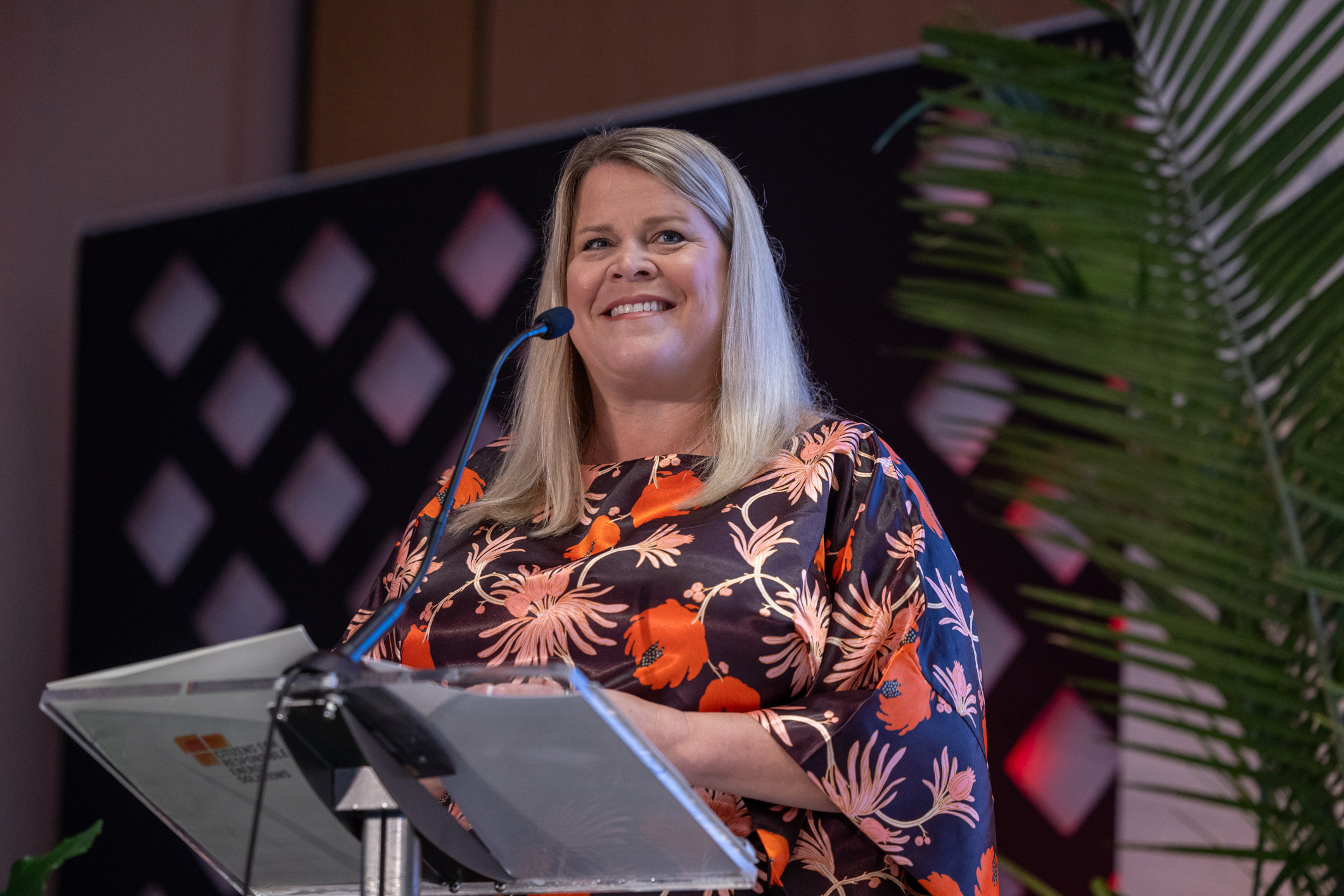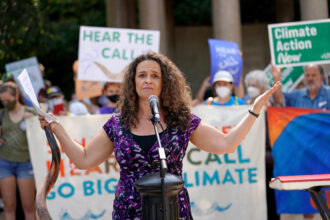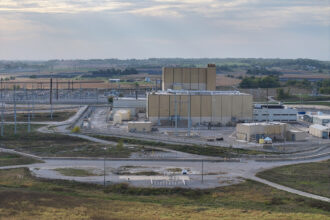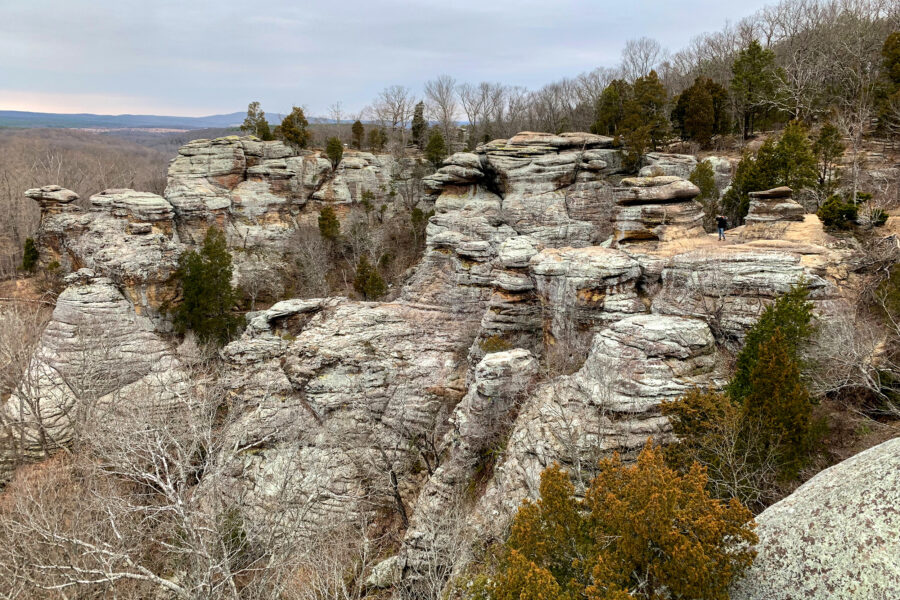Given the deep partisan divides on America’s energy future, heralding the potential of bipartisan action on clean power might seem to some like a fool’s errand.
Since the first day of his second term, President Donald Trump has launched an assault on renewable energy while taking significant steps to boost the fossil fuel industry. The president has made clear his disdain for wind and solar, describing them in one Truth Social post as “THE SCAM OF THE CENTURY” while pushing a slew of regulatory actions to curtail their development.
Many congressional Republicans appeared to back that stance in the party’s signature One Big Beautiful Bill Act, significantly accelerating the phaseout of tax credits for wind and solar projects that had been promised federal support under the Inflation Reduction Act.
Some Democrats, in response, have cast doubt on whether they can work in good faith with their Republican colleagues on even technology-neutral legislative priorities for the energy sector amid the administration’s “bad faith” attacks on renewables.
But to one conservative climate advocate, forging a coalition of Republicans and Democrats to support clean power isn’t just possible—it’s the industry’s best chance at averting even worse outcomes.
Heather Reams is the president and CEO of Citizens for Responsible Energy Solutions, a right-of-center organization promoting conservative solutions to reduce emissions and advance clean energy policy.
She has also served as the chair of National Clean Energy Week since its inception in 2017. The event brings together industry voices and lawmakers from across the political spectrum for rounds of speeches and panel discussions on the industry’s top priorities.
This year’s speakers ranged from one of the leaders of the conservative climate movement, U.S. Sen. John Curtis of Utah, to Democratic U.S. Rep. Scott Peters from California and executives from across the clean energy sector.
From hydropower to permitting reform, the two-day policymakers symposium in mid-September highlighted ways in which industry stakeholders and lawmakers across the political divide could cooperate to advance shared energy goals.
The event wasn’t without controversy. Climate protestors interrupted remarks from the first guest, U.S. Sen. Lisa Murkowski of Alaska, targeting her for voting in favor of the One Big Beautiful Bill Act—with one protester holding a sign deriding the entire gathering as “Climate Colonialism Week.”
Michael Greenberg, the leader of activist group Climate Defiance, later told Inside Climate News that the sign was “a reference to the displacement and natural disasters that high-emission/high-impact countries are causing in the Global South.”
“The main reason we were there is to confront Murkowski, and point out the hypocrisy of her being celebrated at a clean energy conference just months after she cast the tie-breaking vote for the ‘Big Evil Bill,’” Greenberg said.
The event’s sponsors also notably included fossil fuel companies like ExxonMobil and BP, and many of the symposium’s speakers spotlighted natural gas as a “clean” energy source, despite significant controversy over its true impact on the climate. Although natural gas produces less carbon dioxide when burned than coal, critics say that leaks of the climate super-pollutant methane during extraction and transportation make it just as harmful for the climate as other fossil fuels.
Following this year’s gathering, Reams spoke to Inside Climate News about why she believes her “big tent” approach—both within the energy sector and on Capitol Hill—is still the best path forward for America’s clean energy future.
This interview has been edited for length and clarity.
AIDAN HUGHES: This has obviously been a challenging year for renewable energy development in the United States, particularly for wind and solar.
Those two technologies have seen significant cuts and efforts to claw back tax credits, permits, approvals, etc., at the federal level. How did those actions affect the planning and tone for this year’s National Clean Energy Week?
HEATHER REAMS: We were talking to our different stakeholders and partners and those that were speaking or sponsoring [National Clean Energy Week], talking to them about their priorities and how they wanted to present them, and making sure it was more in a bipartisan fashion.
And I think everyone we talked to was like, “We really want bipartisanship. We’re not after partisanship.”
And then talking to members of Congress as they were coming to make their comments, I think they were also looking at a “We need every electron,” more of an abundance type of argument—whether they were Republicans or Democrats, talking about the demand for energy.
So I think there was more of a “Let’s reset where we’ve been, post-reconciliation tax credits, and focus on what our country needs to be competitive.” …
I’ll flag, also, that the week before clean energy week, I was at [renewable energy conference] RE+ in Las Vegas. I found that same tone there. … We’re beyond tax credits now, and we’re ready to solve big problems. So I was pleasantly surprised to see that the renewable energy industry, while they have some bumps and bruises, were ready to move forward, are looking towards permitting reform that will help create more business certainty and reduce costs, and we’re prepared to be part of the conversation.
HUGHES: On that note, despite the challenges that the industry has faced this year, there was a significant amount of optimism during the policymakers symposium from both industry voices and lawmakers about the future of clean energy.
So what do you see as the path forward for clean energy to make the case to policymakers at the federal level and at the state level, that it’s a necessary investment for both the environment and the economy?
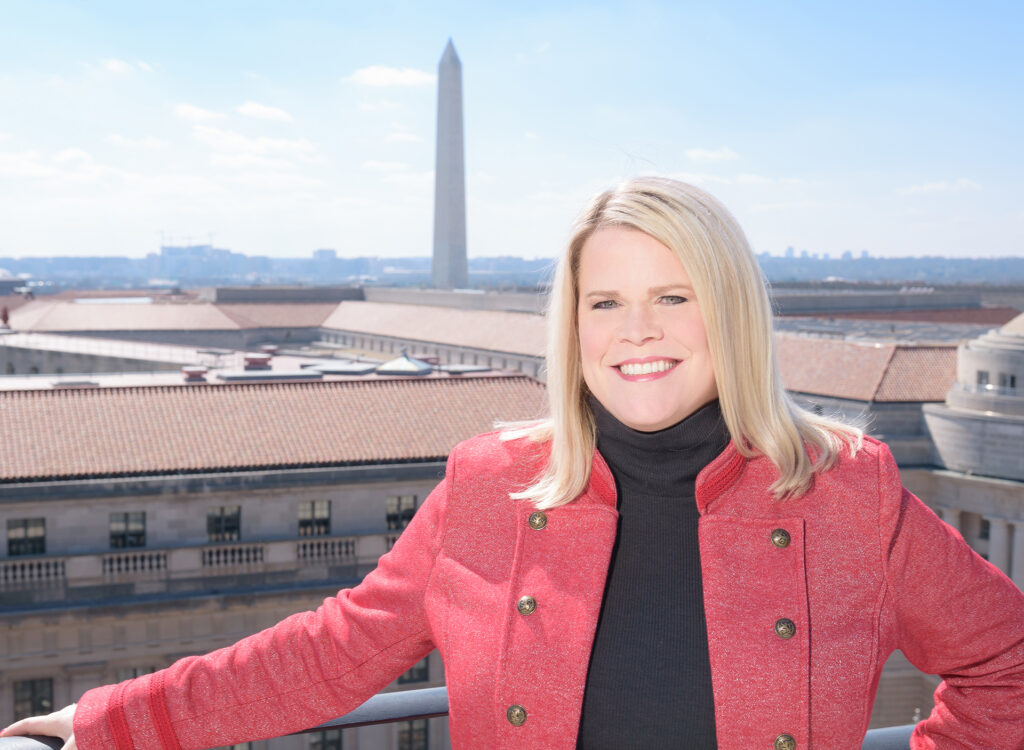
REAMS: By removing renewable energy, you’re not only reducing choices, but you’re increasing—potentially increasing—prices. So I think that’s one piece.
I think another piece is that it’s the jobs, right? The innovations that renewable energies have brought, have [also] brought good-paying jobs in all parts of the country. … These are jobs that are going to keep our country economically competitive with other nations.
And there’s a lot of talk about competition with China, and how China is producing so much more, but the innovation is on our side. … We are the innovators even though China does manufacture a lot of what we end up inventing.
So I think there’s [an] “all of the above”/abundance piece, and depending which side of the aisle you’re sitting on, it is actually the Venn diagram bringing Republicans and Democrats together to acknowledge that to move forward as a country, we need to be able to keep prices low, and we need all the energy we can get.
HUGHES: You’ve mentioned a couple of times now that emphasis on bipartisanship.
That emphasis was clear through the diverse range of lawmakers that were invited to speak at the event, from [Republican] Congressman Bruce Westerman to [Democratic] Rep. Scott Peters.
The symposium started, though, with a pushback against that. … The group Climate Defiance interrupted Sen. Lisa Murkowski’s speech, in protest against her role in passing the One Big Beautiful Bill Act, which made significant cuts to wind and solar.
So what would you say to those who would argue that lawmakers who voted for measures that have had a negative impact on the development of clean energy shouldn’t be getting a platform at National Clean Energy Week?
REAMS: I would consider this group to be a more extreme group, a left group. And then there are extreme groups on the right as well. And they have their role and purpose. We didn’t love having the protesting, but we recognize it can happen.
A couple things on the bill. Lisa Murkowski—first, she was instrumental in helping the reconciliation bill that came out of the Senate not be as bad, and she deserves a lot of credit for that. There are a handful of members in the Senate that were working to remove provisions like an excise tax on renewable energy that would have been detrimental to the industry.
A protest like that doesn’t give her that credit. It only looks at the outcome of the vote versus the process that goes on in developing these bills.
Second, the bill is huge. That bill did a lot for energy, but it also was focused a lot on nutrition, SNAP benefits, defense, immigration. It wasn’t a vote on one singular issue. It was a mega-bill with a lot of GOP priorities and the political pressure was really significant.
We, [a] number of organizations, really, were working just to make the bill better for renewable energy. And we knew that was probably the best we can get based on the political makeup of Congress, and of course the president being Republican.
And then three, there are plenty of members of Congress who have never supported renewable energy on the right—have not been a champion for renewable energy, [haven’t] talked about it, [haven’t] tried to protect it.
And if you’re really going to protest somebody, I think there are just better members to protest than Lisa Murkowski. She’s one of the most productive Republican members on “all the above,” both for renewables and fossil fuels.
So I know it’s convenient to protest an event that’s open to the public and open to the press and speak like that, but in the end, I think she was able to message and show “people can be upset with the outcomes. I’m not entirely happy with the outcome, but this is what we’re going to do moving forward.”
I think she acknowledged the frustration of others, including herself, and is ready to move on.
HUGHES: We’ve seen a significantly shifting landscape for renewable energy across recent administrations.
Just in the past few years, for example, you had this massive boost to the development of new renewable projects through the tax credits and promises made in the Inflation Reduction Act from former President Biden and a Democrat-controlled Congress, only for many of those commitments to be scaled back by the Trump administration and a Republican-controlled Congress.
What would you say to businesses who might be worried that clean energy simply isn’t a safe or reliable investment given the pendulum swing of U.S. policy with each change in administration?
REAMS: I’d say—I wouldn’t actually put this towards clean energy. I would say that any business that wants to invest in the United States is concerned about investing in the United States now.
There’s no research on the amount of capital that’s not being deployed right now because of the uncertainty. But I can imagine it’s a pretty big number, and a frightening number because of the regulatory uncertainty that we see, and that’s a problem for the competitiveness of our country.
It’s not just clean energy. I talked to a lot of energy companies on the fossil fuel side that are concerned. I talked to a lot of multinational companies that do lots of manufacturing that are concerned. And so I think American policy makers, regardless of what letter is next to their name, should be concerned and should be taking measures to create more stability in our regulatory framework.
I think a place to start would be in permitting to create some more certainty. But certainly the volatility in the U.S. is not putting out the welcome mat for companies to come and invest and build. So it’s unfortunately not just clean energy companies that are experiencing this volatility.
This story is funded by readers like you.
Our nonprofit newsroom provides award-winning climate coverage free of charge and advertising. We rely on donations from readers like you to keep going. Please donate now to support our work.
Donate NowHUGHES: National Clean Energy Week highlighted a variety of energy sources and technologies ranging from hydropower to nuclear power.
One of the sources that received a significant amount of attention, though, was natural gas.
There’s obviously some controversy surrounding natural gas as a clean energy source. According to the co-director of the MIT Climate and Sustainability Consortium, if methane emissions from natural gas are on the high end of current estimates, natural gas may be no cleaner of an energy source than coal.
National Clean Energy Week’s sponsors also included fossil fuel interests, including ExxonMobil, BP and the American Gas Association.
So how would you respond to critics who might argue that these technologies and industries shouldn’t be part of the conversation when it comes to promoting clean energy?
REAMS: I think that’s been one of the problems with talking about the transition from fossil fuels to lowering emissions, right? Whether it’s just transition and getting to a more “all the above,” a mix of fossil fuels and renewable energy.
There’s a lot of talk about eventually going to solar and wind, plus peaker plants for gas as a longer-term solution, until we can come up with the next technology that’s going to help lower emissions. So that includes peaker plants with natural gas, right?
I think credit should be given where credit’s due. Displacing coal with natural gas has reduced emissions by 40 percent in the United States. So is that cleaner? Yes. Is it the cleanest? No—but it’s cleaner.
Every technology has its drawbacks, and what we’re seeing is that carbon capture and methane capture, plus natural gas, is going to help reduce emissions.
Normally, energy in our country has been additive. I don’t really see that changing. But what we do see a lot of changes is with the innovations that can help improve this technology. So that’s why we’re looking at natural gas plus carbon capture plus methane capture, and giving those policies a voice at the table. So we did have people talking about carbon capture, for instance, as part of a solution—innovative technologies.
So right now, we believe in a bigger tent—a tent that is going to allow entities to be able to share their perspectives and their solutions.
Another piece that often goes unnoticed is that fossil fuel companies are funding a lot of R&D on lower-carbon technologies. Hydrogen, for instance, or like [carbon capture and storage] and [carbon capture utilization and storage]. So they’re putting a lot of money into this, and they deserve to have a seat at the table, because they are trying to reduce emissions.
I think a bigger tent is going to help us not create the “who can and who shouldn’t be at the table,” but really be a more inclusive place for us to solve big problems together.
That’s one of the problems that I’ve seen with one side of the aisle, the Democratic party, trying to solve climate change. It isn’t working. The policies aren’t durable.
We need left and the right, Republicans and Democrats, trying to solve big problems. And climate change is a very big problem that we need to solve, and we’re not going to do it with just a slice or sliver of the population or the industry trying to solve it.
About This Story
Perhaps you noticed: This story, like all the news we publish, is free to read. That’s because Inside Climate News is a 501c3 nonprofit organization. We do not charge a subscription fee, lock our news behind a paywall, or clutter our website with ads. We make our news on climate and the environment freely available to you and anyone who wants it.
That’s not all. We also share our news for free with scores of other media organizations around the country. Many of them can’t afford to do environmental journalism of their own. We’ve built bureaus from coast to coast to report local stories, collaborate with local newsrooms and co-publish articles so that this vital work is shared as widely as possible.
Two of us launched ICN in 2007. Six years later we earned a Pulitzer Prize for National Reporting, and now we run the oldest and largest dedicated climate newsroom in the nation. We tell the story in all its complexity. We hold polluters accountable. We expose environmental injustice. We debunk misinformation. We scrutinize solutions and inspire action.
Donations from readers like you fund every aspect of what we do. If you don’t already, will you support our ongoing work, our reporting on the biggest crisis facing our planet, and help us reach even more readers in more places?
Please take a moment to make a tax-deductible donation. Every one of them makes a difference.
Thank you,


